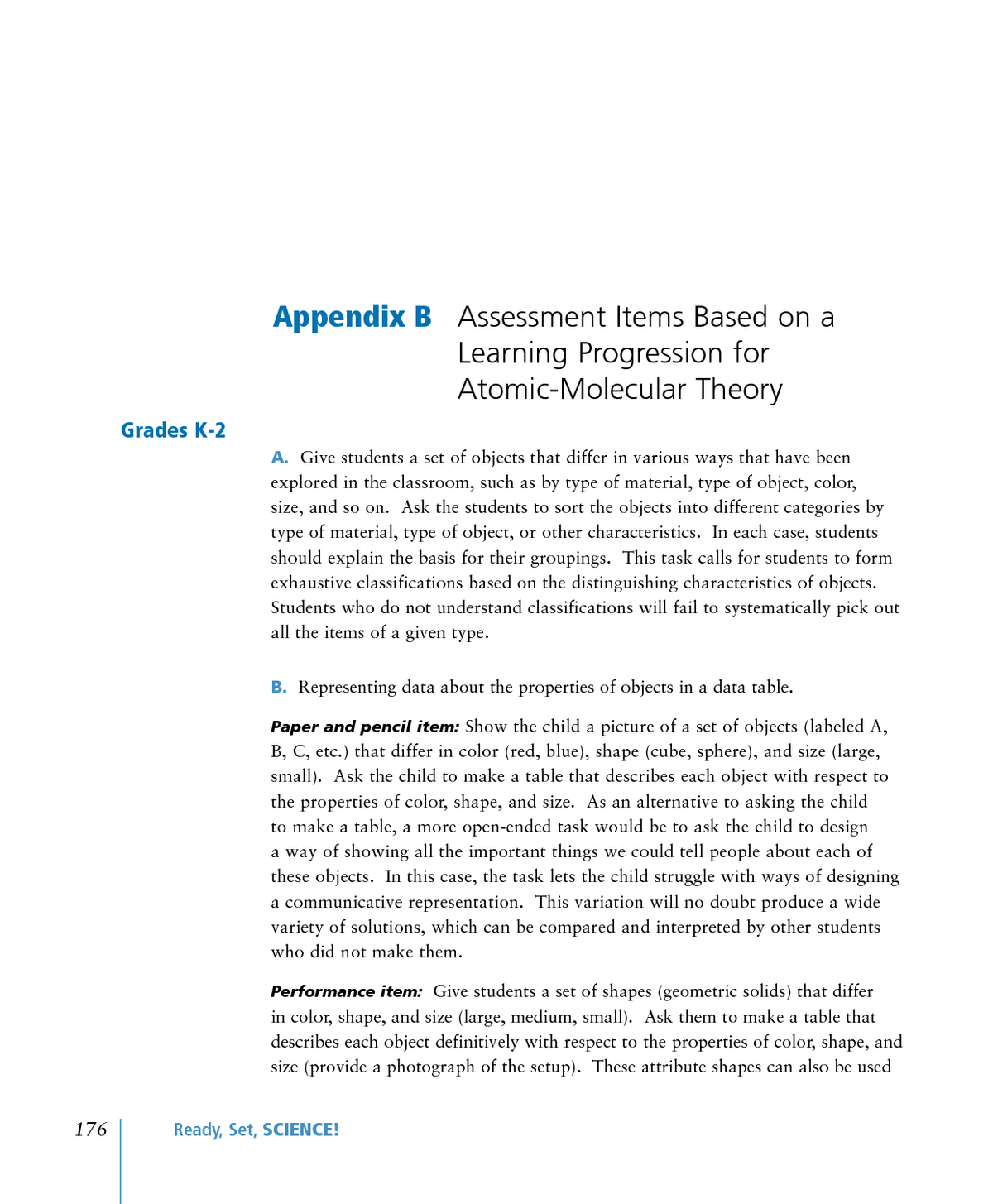


Below is the uncorrected machine-read text of this chapter, intended to provide our own search engines and external engines with highly rich, chapter-representative searchable text of each book. Because it is UNCORRECTED material, please consider the following text as a useful but insufficient proxy for the authoritative book pages.
Appendix B Assessment Items Based on a Learning Progression for Atomic-Molecular Theory Grades K-2 A. Give students a set of objects that differ in various ways that have been explored in the classroom, such as by type of material, type of object, color, size, and so on. Ask the students to sort the objects into different categories by type of material, type of object, or other characteristics. In each case, students should explain the basis for their groupings. This task calls for students to form exhaustive classifications based on the distinguishing characteristics of objects. Students who do not understand classifications will fail to systematically pick out all the items of a given type. B. Representing data about the properties of objects in a data table. Paper and pencil item: Show the child a picture of a set of objects (labeled A, B, C, etc.) that differ in color (red, blue), shape (cube, sphere), and size (large, small). Ask the child to make a table that describes each object with respect to the properties of color, shape, and size. As an alternative to asking the child to make a table, a more open-ended task would be to ask the child to design a way of showing all the important things we could tell people about each of these objects. In this case, the task lets the child struggle with ways of designing a communicative representation. This variation will no doubt produce a wide variety of solutions, which can be compared and interpreted by other students who did not make them. Performance item: Give students a set of shapes (geometric solids) that differ in color, shape, and size (large, medium, small). Ask them to make a table that describes each object definitively with respect to the properties of color, shape, and size (provide a photograph of the setup). These attribute shapes can also be used 176 Ready, Set, SCIENCE!
in the Mystery Box activity, getting students to ask questions to identify which object (by color, shape, and size) is inside the box. Performance item: Give students a set of objects that vary along a given dimen- sion (length, area, weight, or volume). Ask them to measure the dimension in question and make a data table that shows the values of each of the objects for that dimension. Interpretation: These items call for students to construct simple but organized tables to represent their data in clear ways. An important aspect of their perfor- mance would be their ability to describe each object accurately and completely according to all the properties or dimensions in question and to have separate columns (or rows) for each property or dimension. Grades 3-5 Paper and pencil item: Here are two empty balloons in balance. (Show pic- ture or drawing of two uninflated balloons in balance, each hanging from the end of a rod that is suspended with a string tied to its midpoint.) Which of the following pictures shows what will happen when one balloon is filled with air? How do you know? A. Picture shows the uninflated and inflated balloons are both still in balance. B. Picture shows the inflated balloon is heavier (tips down). C. Picture shows the inflated balloon is lighter (tips up). D. There is no way to predict from the information given. Interpretation: This item assesses whether students realize that air has weight and hence that adding air will make the balloon heavier and the rod tip down. If students understand this, they should select B and explain that air has weight, so it should make the rod go down. Common alternative ideas are that air is weightless (adding air will not change how things balance) or that air has negative weight (things rise when air is in them, so the side of the rod with the balloon will go up). Other items could be created, asking about the weight of a ball (or tire) as air is added or removed. Appendix B 177
Grades 6-8 Paper and pencil item: A container with a little hole at the top is placed over a hot plate. There is water in the container. A deflated balloon is attached to the hole. The hot plate is turned on. The water starts boiling and the bal- loon inflates (see picture): 1. What is the balloon filled with? A. Air B. Oxygen and hydrogen gas C. Air and water vapor Hot plate (cold) Hot plate (hot) D. Heat 2. Consider the combined mass (amount of stuff) of the container, water, and bal- loon (deflated or inflated) and what the balloon contains. When the water boils: A. Mass (amount of stuff) stays the same because________________________ B. Mass (amount of stuff) decreases because_____________________________ C. Mass (amount of stuff) increases because_____________________________ D. There is no way to predict. Interpretation: These questions test whether students believe that what escapes from the boiling water is material, whether they apply conservation of mass to this situation, and what they think escapes from the water. The proportion of students who believe that what escapes from boiling water is still water increases through middle school. Some students believe that what escapes from the boiling water is air, or they might say that the water breaks down into oxygen and hydrogen (evincing a confusion between chemical and physical transformations). Students may correctly apply conservation of mass and predict that when the liquid water changes state, there is no change in mass. Alternatively, they may believe that the mass of the gas will be less than the mass of liquid because gases are thought to be light or weightless. 178 Ready, Set, SCIENCE!
